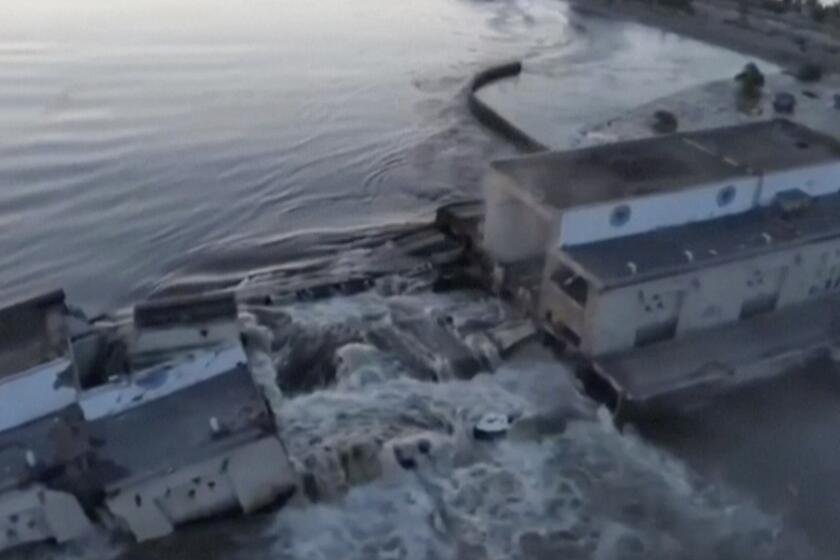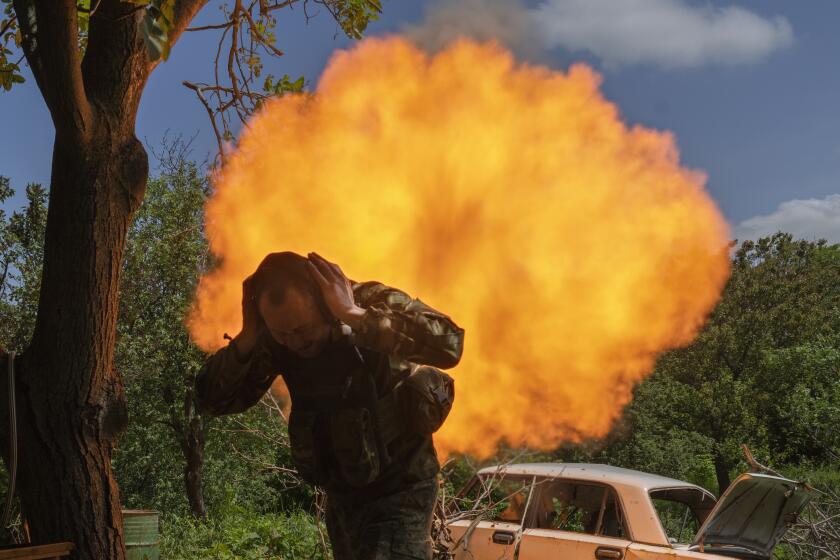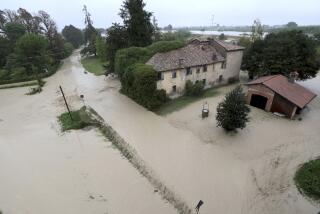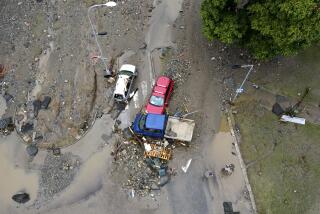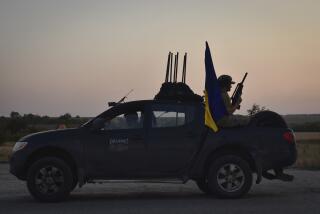Floodwaters swamp more areas of Ukraine as hundreds flee after dam breach
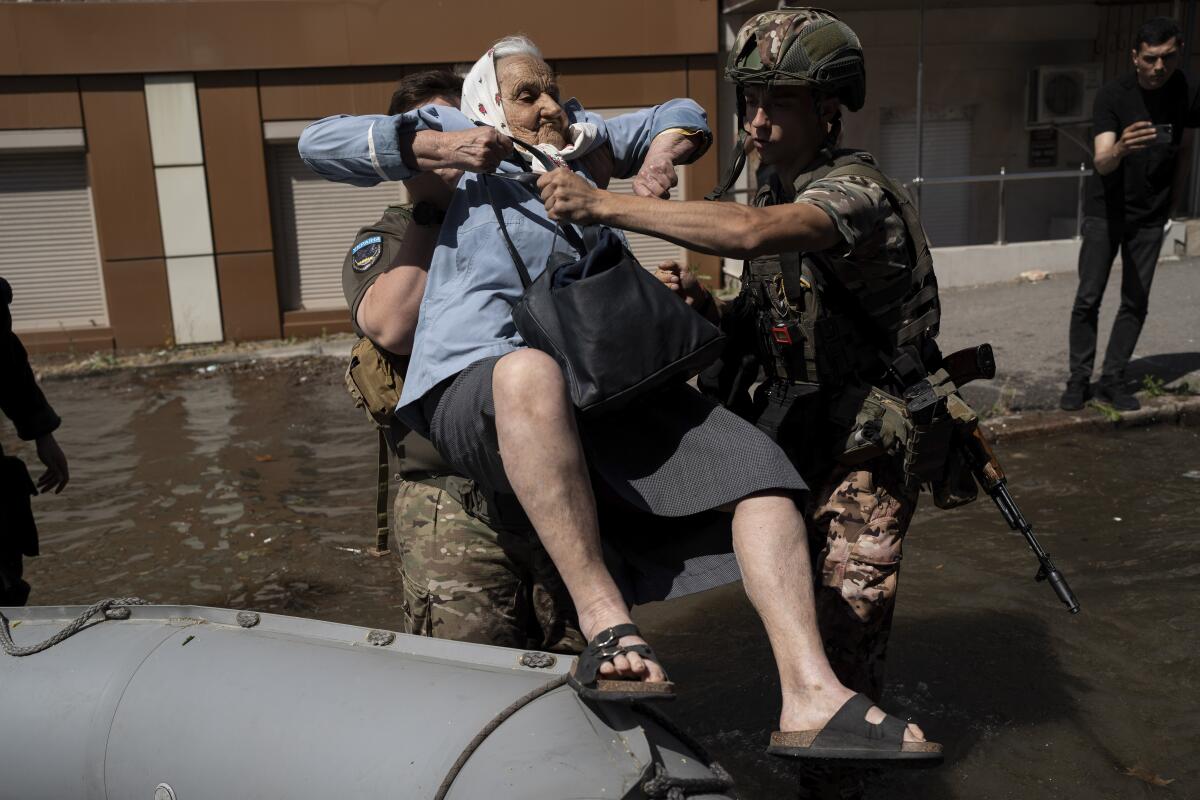
- Share via
KHERSON, Ukraine — Authorities on Wednesday rushed supplies of drinking water to flooded areas from a collapsed dam in southern Ukraine as officials weighed where they might have to resettle thousands of residents who relied on the breached reservoir on the Dnipro River that forms part of the front line in the 15-month war.
About 3,000 people have been evacuated from flooded areas on both the Russian- and Ukrainian-controlled sides of the river, officials said, but it was not clear whether the true scale of the disaster had yet emerged in an affected area that was home to more than 60,000 people. Russian-appointed authorities in the occupied parts of the Kherson region reported 15,000 homes were flooded.
Some residents of Russian-occupied areas hit by high water complained that help was slow in arriving.
The Kakhovka hydroelectric dam and reservoir, one of the largest in the world and essential for the supply of drinking water and irrigation to a huge area of southern Ukraine, lies in a part of the Kherson region occupied by Moscow’s forces for the last year. It is also critical for water supplies to the Crimean peninsula, which was illegally annexed by Russia in 2014.
Ukraine holds the western bank of the Dnipro, and Russia controls the eastern side, which is lower and more vulnerable to flooding.
Scenes of flooded communities and rescues by boat and from rooftops called to mind a natural disaster, rather than those usually seen in war.
The flooding could wash away this season’s crops, and the depleted Kakhovka reservoir would deny adequate irrigation in the years ahead.
The rupture of the dam that impounds Ukraine’s largest reservoir released a torrent of water, raising fears of widespread damage and flooding.
A day after the dam’s collapse, it remained unclear what caused it, with both sides blaming each other for the destruction. Some experts said it might have been due to wartime damage and neglect, although others argued that Russia could have had military reasons to destroy it.
Many residents had long ago fled the region due to the fighting, but others stayed despite shelling and drone attacks, making it hard to determine how many people remain at risk in an area where hundreds of thousands lived before Russia’s February 2022 invasion.
Ukrainian President Volodymyr Zelensky said he met with officials on the “urgent provision of drinking water and long-term solutions for settlements that were dependent on the reservoir,” as well as assessing damage to property and the environment in the region.
Zelensky accused Moscow-installed officials in occupied areas of failing to respond adequately to the emergency.
Russian-installed authorities said they evacuated fewer than 1,300 people in an area where at least 22,000 people were said to have been affected. That compared with about 1,700 evacuated on the Ukrainian side, where the population was reportedly around 42,000.
In the Moscow-controlled city of Oleshky, Lera told the Associated Press that the first floor of her home is flooded, confining her and her family to the second floor.
“Everything around us is floating, people are standing on rooftops and asking for help, but no one is evacuating them,” said the 19-year-old, who declined to give her last name out of fear of reprisals.
Most Russian troops fled Oleshky shortly after the dam incident, Lera said, although a military checkpoint remains, and boats with people trying to leave have come under fire from soldiers. Her claim could not be independently verified.
She said other residents are running out of food, and her own home has no power or drinking water.
Civilians in Kherson carried personal belongings as they waded through knee-deep water in the streets and rode rubber rafts. Video on social media showed rescuers carrying people to safety, and what looked like the triangular roof of a building floating downstream.
Aerial footage showed flooded streets in the Russian-controlled city of Nova Kakhovka on the eastern side of the Dnipro, where Mayor Vladimir Leontyev said seven people were missing, although they were believed to be alive.
Animals also were caught in the flood, with some pets trapped. Officials at the Kazkova Dibrova Zoo in Nova Kakhovka said it was under water and that “only swans and ducks could escape.”
Zelensky said Ukraine would appeal to international organizations for help.
A 2-year-old was killed and at least 25 people were injured, including five children, in a Russian airstrike on Dnipro, Ukraine, according to President Volodymyr Zelensky.
In his first public comments on the disaster, Russian President Vladimir Putin repeated Moscow’s line that Ukraine is to blame for destroying the Kakhovka dam.
In a call with Turkish President Recep Tayyip Erdogan, Putin alleged that Kyiv authorities had escalated “war crimes, openly using terrorist methods and staging acts of sabotage on the Russian territory,” the Kremlin said in its account of the call.
It was unclear how the dam disaster would affect the war just as Ukraine appeared to be preparing for a counteroffensive against Russian troops. Amid the disaster response, artillery boomed as people scrambled to leave the area.
Addressing who might be to blame, the Institute for the Study of War, a Washington think tank, said Russia has “a greater and clearer interest in flooding the lower [Dnipro] despite the damage to their own prepared defensive positions.”
Amid speculation that Ukraine might have begun its long-awaited counter-offensive, the institute said Russian forces may think breaching the dam could cover a possible retreat and delay Ukraine’s campaign.
Russian forces declared victory in the eastern city last month, but Ukrainian defenders continue to fight from positions on the western fringes.
Experts noted that the dam, about 45 miles east of the city of Kherson, was believed to be in disrepair and vulnerable to collapse because water was already brimming over when the wall gave way. It hadn’t been producing power since November, according to officials.
Britain’s Ministry of Defense said the Kakhovka reservoir was at record high levels before the breach. While the dam wasn’t entirely washed away, the ministry warned that its structure “is likely to deteriorate further over the next few days, causing additional flooding.”
The scale of the damage to the dam was unknown, but officials hoped to rebuild the complex once the Russians leave, said Ihor Syrota, general director of Ukrainian national hydroelectric company Ukrhydroenergo. Authorities, meanwhile, are holding water in upstream reservoirs to compensate in part for the loss of the dam, he said.
Wheat and corn prices surged Tuesday as the dam collapse raised fears about the fragility of Ukraine’s ability to ship its crucial grain supplies to developing nations where people are struggling with hunger and high food prices. Prices stabilized Wednesday after markets had reacted to signals of an escalation in the war that could upend a shaky agreement allowing Ukraine to export wheat, corn, sunflower oil and other food to the world through the Black Sea
Both sides warned of environmental disaster from polluted waters, partly caused by oil leaking from the dam’s machinery.
Ukrainian and Russian officials, as well as the U.N., have said it will take days to assess the damage, warning of a long recovery period.
More to Read
Sign up for Essential California
The most important California stories and recommendations in your inbox every morning.
You may occasionally receive promotional content from the Los Angeles Times.
